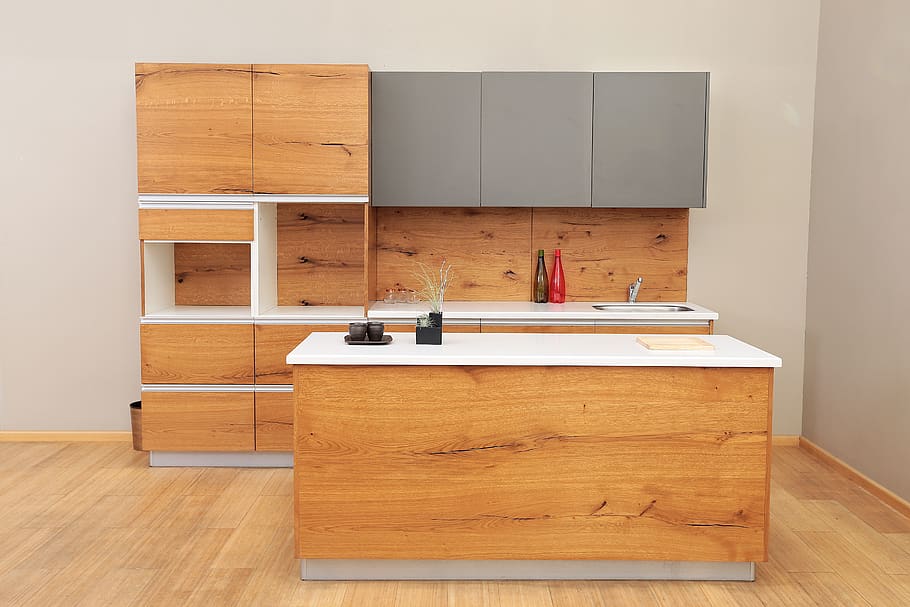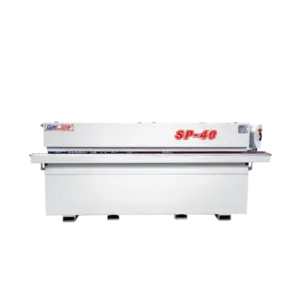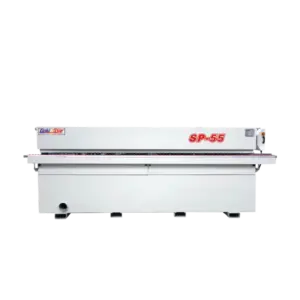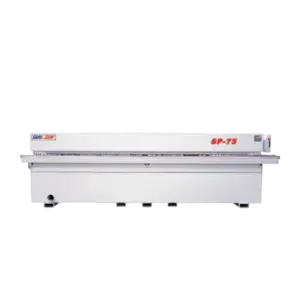Installing melamine edge banding with a woodworking or cabinet making automated machine offers a wide range of advantages over manual methods using rudimentary tools. This automated process ensures precision, efficiency, and consistency, resulting in a flawless finish and enhanced productivity.
One of the key advantages of using automated edgebander machines for melamine edge banding is the precise application it offers. These machines are specifically designed to handle melamine edge banding, providing consistent pressure and temperature control throughout the process. This ensures that the edge banding is applied evenly and securely, resulting in a seamless finish. Manual installation using rudimentary tools can often lead to uneven application, gaps, or bubbles in the edge banding, compromising the quality and aesthetics of the final product.
Another significant benefit of using an automated machine is the speed and efficiency it brings to the installation process. These machines are equipped with advanced technology and mechanisms that allow for rapid application of the edge banding. They can handle large volumes of work in a short amount of time, significantly reducing installation time and labor costs. Manual installation, on the other hand, can be time-consuming and labor-intensive, especially when dealing with a high volume of projects. By automating the process, professionals can optimize their workflow, increase productivity, and meet deadlines more efficiently.
The accuracy and precision offered by automated machines also minimize the risk of errors and rework. These machines are designed to cut the edge banding to the exact dimensions required, ensuring a precise fit. This eliminates the need for manual trimming and reduces the chances of mistakes or inaccuracies. Additionally, automated machines can be programmed to handle complex shapes and curves, allowing for seamless edge banding even on intricate designs. Manual installation using rudimentary tools can be challenging, especially when dealing with curved or irregular surfaces. The risk of errors, wasted materials, and the need for additional work are significantly reduced when using an automated machine.
Furthermore, automated machines offer a higher level of safety during the installation process. These machines are equipped with safety features and mechanisms to prevent accidents and injuries. They are designed to minimize the risks associated with handling sharp tools and working with high temperatures. Manual installation using rudimentary tools, especially when inexperienced or untrained individuals are involved, can pose a greater risk of accidents and injuries. By utilizing an automated machine, professionals can prioritize safety and create a more secure working environment.
Cost-effectiveness is another advantage of using an automated machine for melamine edge banding. While the initial investment may be higher compared to purchasing rudimentary tools, the long-term benefits outweigh the cost. Automated machines increase productivity, reduce labor costs, minimize errors and rework, and optimize workflow. These factors contribute to significant savings in the long run. Additionally, the consistent and high-quality finish achieved with an automated machine enhances the value and marketability of the final product, ultimately leading to higher customer satisfaction and potentially higher profits.
Installing melamine edge banding manually
Melamine edge banding is a thin strip of melamine material that is applied to the exposed edges of plywood, particleboard, or MDF (medium-density fiberboard) to cover any unsightly edges or imperfections. It provides a smooth, seamless finish that matches the surface of the panel, giving the appearance of a solid piece of material.
Before you begin the manually installation process, gather the necessary tools and materials. You will need a few basic tools such as a utility knife, a hot air gun or an iron, a roller, and a file. Additionally, you will need the melamine edge banding itself, which is available in various widths and colors to match your project.
To start the installation, ensure that the edges of the substrate are clean, smooth, and free from any dust or debris. If necessary, sand the edges lightly to create a smooth surface for the adhesive to adhere to. It is important to note that melamine edge banding is typically applied to the edges that are perpendicular to the surface, not the edges that are parallel to it.
Next, measure and cut the melamine edge banding to the appropriate length, leaving a slight overhang on both ends. This overhang will be trimmed later to achieve a precise fit. It is recommended to cut the edge banding slightly longer than the edge to allow for adjustments during installation.
Before applying the edge banding, preheat the hot air gun or iron to the recommended temperature. This will ensure proper adhesion and activation of the adhesive on the back of the edge banding. Carefully position the edge banding onto the substrate, aligning it flush with one edge and leaving the excess overhang on the opposite side.
Using the hot air gun or iron, apply heat to the edge banding while pressing it firmly onto the edge. The heat activates the adhesive, allowing it to bond securely to the substrate. Work slowly and methodically, applying heat evenly along the length of the edge banding to ensure a strong bond. As you proceed, use a roller to firmly press the edge banding onto the substrate, eliminating any air bubbles or wrinkles.
Once the edge banding is fully applied, allow it to cool and set for a few minutes. Then, using a sharp utility knife, carefully trim the excess overhang flush with the edge of the substrate. Take your time to achieve clean and precise cuts, ensuring a seamless transition between the edge banding and the surface.
After trimming, inspect the installed edge banding for any imperfections or rough edges. Use a file or sandpaper to smooth out any rough spots or uneven edges, creating a seamless and polished finish. Finally, clean the surface with a damp cloth to remove any adhesive residue or dust.
With the melamine edge banding properly installed, you have transformed the exposed edges of your furniture or cabinetry into a professional and finished look. The edge banding not only enhances the visual appeal of your projects but also provides an additional layer of protection against moisture, impact, and wear.
It is important to note that proper installation techniques and attention to detail are crucial for achieving a high-quality and long-lasting result. Practice on scrap pieces before working on your actual project to familiarize yourself with the process and perfect your technique.
In conclusion, installing melamine edge banding is a simple yet effective way to elevate the appearance and durability of your woodworking projects. With the right tools, materials, and techniques, you can achieve seamless and professional-looking edges that will impress and endure.
However, installing melamine edge banding with a woodworking or cabinet making automated machine offers numerous advantages over manual methods using rudimentary tools. The precision, efficiency, consistency, accuracy, safety, and cost-effectiveness provided by automated machines make them the preferred choice for professionals in the woodworking and cabinet making industry. By utilizing these machines, professionals can achieve flawless finishes, increase productivity, minimize errors, optimize workflow, and ultimately deliver high-quality products to their customers.




